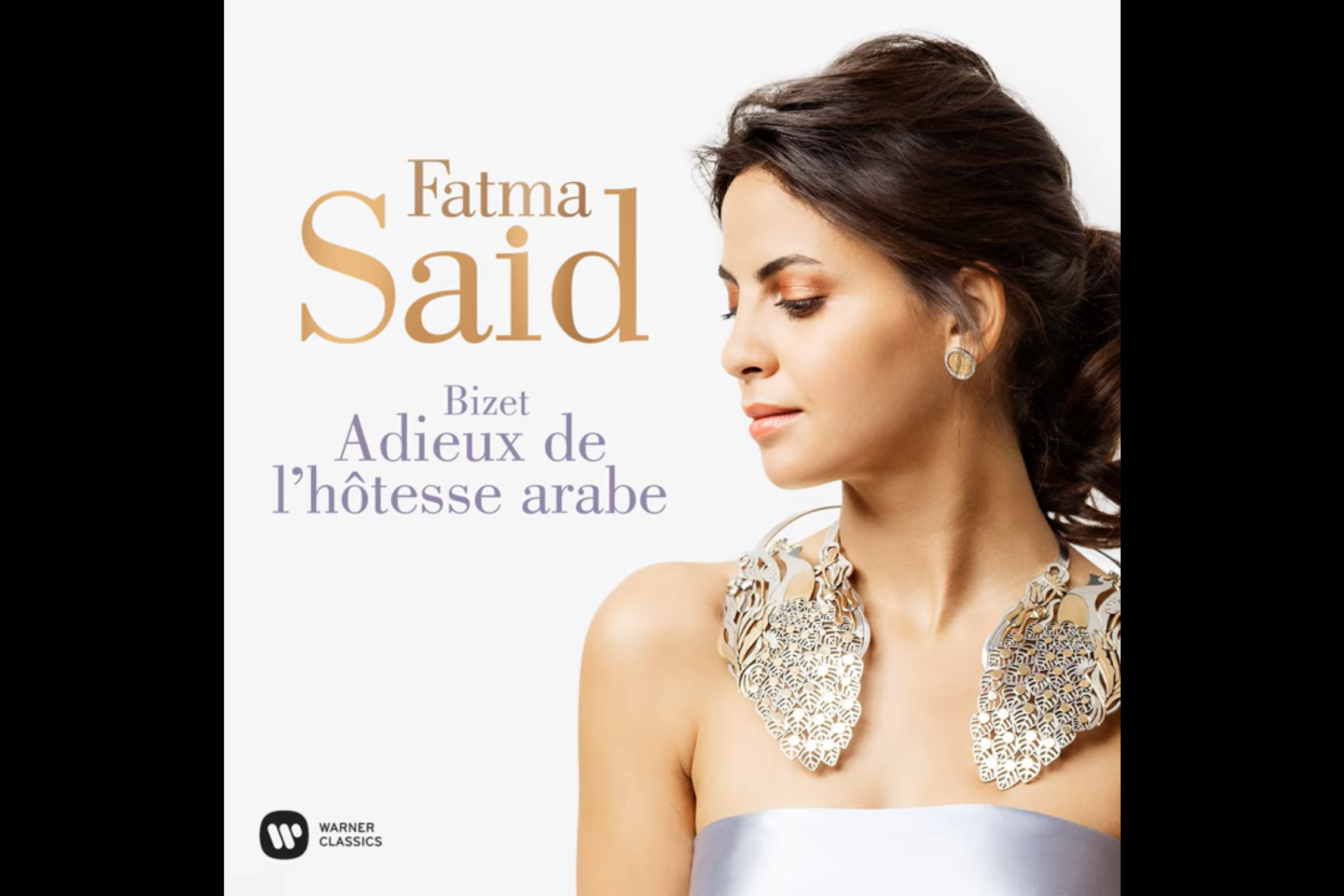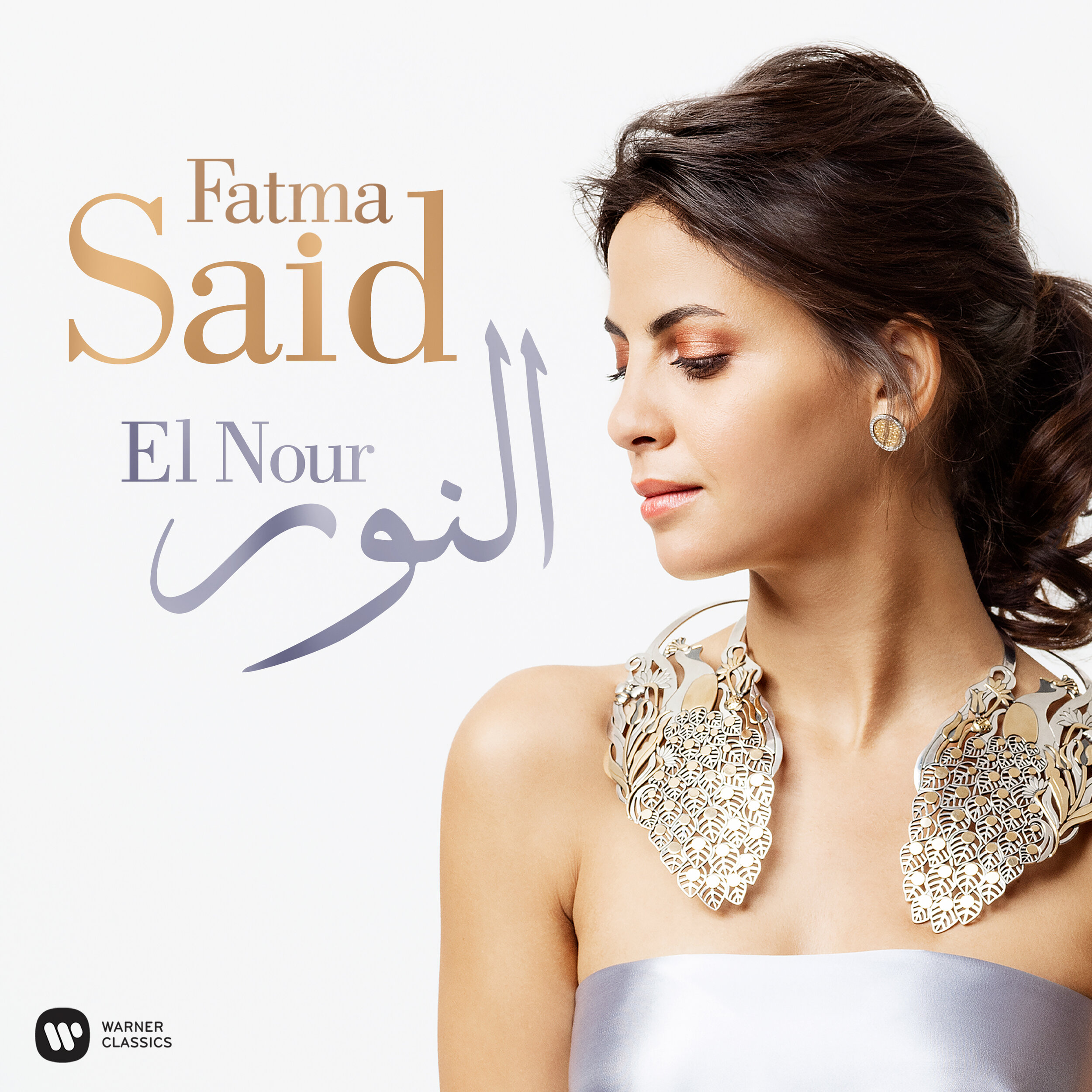New album “Lieder” out now!
While soprano Fatma Said’s previous Warner Classics releases crossed cultures and musical genres, this album focuses entirely on German-language songs of the Romantic era: Lieder by Schubert, Mendelssohn, Schumann and Brahms. At the age of 18 Fatma left her native Cairo to study at the Hanns Eisler Conservatory in Berlin and
“Ever since my time at the German school in Cairo, the joy of singing this genre has been central to my musical life … I am very passionate about lieder … This wonderful combination of great German poetry and genius composers like Schubert, Schumann, Mendelssohn, and Brahms.”
In the conventional course of things, a lieder recital involves one singer and one pianist, but Fatma Said, saying “I’ve always wanted to make music with friends”, has called on the talents of pianist Malcolm Martineau and Joseph Middleton, alongside harpist Anneleen Lenaerts, clarinettist Sabine Meyer (in Schubert’s ‘Der Hirt auf dem Felsen’), Quatuor Arod (accompanying Brahms’ Ophelia-Lieder in an arrangement by Aribert Reimann), male-voice ensemble Walhalla zum Seidlwirt with their own pianist member Yonatan Cohen, and another singer on the ascent – baritone Huw Montague Rendall. The programme features some of the world’s best-loved lieder, such as Schubert’s ‘Ständchen’, Schumann’s ‘Widmung’ and Brahms’ ‘Wie Melodien zieht es mir’, but it also explores less familiar repertoire. Throughout the album, Fatma Said places a crucial emphasis on the poetic texts:
“My priority was to convey the characterisation of the words most of all … Differentiating between diverse kinds of expressive worlds is for me what lieder-singing is all about.”
TRACKLIST LIEDER
1. Schubert: Schwanengesang, D. 957: No. 4, Ständchen
Fatma Said, Malcolm Martineau
2. Schubert: Der Hirt auf dem Felsen, D. 965
Fatma Said, Malcolm Martineau, Sabine Meyer
3. Schubert: Ständchen, D. 920 "Zögernd leise"
Fatma Said, MGV Walhalla zum Seidlwirt, Yonatan Cohen
4. Mendelssohn: 6 Gesänge, Op. 86: No. 3, Die Liebende schreibt, MWV K66
Fatma Said, Joseph Middleton
5. Schubert: Auf dem Wasser zu singen, Op. 72, D. 774
Fatma Said, Malcolm Martineau
6. Schubert: Der Zwerg, D. 771
Fatma Said, Malcolm Martineau
7. Mendelssohn: 12 Gesänge, Op. 8: No. 8, Hexenlied, MWV K33
Fatma Said, Joseph Middleton
8. Mendelssohn: 6 Gesänge, Op. 34: No. 4, Suleika, MWV K92
Fatma Said, Joseph Middleton
9. Mendelssohn: 6 Duette, Op. 63: No. 1, Ich wollt, meine Lieb’ ergösse sich, MWV J5
atma Said, Huw Montague Rendall, Joseph Middelton
10. Mendelssohn, Fanny: Suleika und Hatem (From Felix Mendelssohn’s Op. 8)
Fatma Said, Huw Montague Rendall, Joseph Middelton
11. Brahms: 4 Lieder, Op. 70: No. 2, Lerchengesang (Version with Harp)
Fatma Said, Anneleen Lenaerts
12. Brahms: 5 Lieder, Op. 105: No. 1, Wie Melodien zieht es mir (Version with Harp)
Fatma Said, Anneleen Lenaerts
13. Brahms: 49 Deutsche Volkslieder, WoO 33, Vol. 1: No. 6, Da unten im Thale (Version with Harp)
Fatma Said, Anneleen Lenaerts
14. Brahms: 5 Lieder, Op. 105: No. 2, Immer leiser wird mein Schlummer (Version with Harp)
Fatma Said, Anneleen Lenaerts
15. Brahms: 5 Ophelia-Lieder, WoO 22: No. 1, Wie erkenn ich den Treulieb (Arr. Reimann for Voice and String Quartet)
Fatma Said, Quatuor Arod
16. Brahms: 5 Ophelia-Lieder, WoO 22: No. 2, Sein Leichenhemd Weiss wie Schnee zu sehn (Art. Reimann for Voice and String Quartet)
Fatma Said, Quatuor Arod
17. Brahms: 5 Ophelia-Lieder, WoO 22: No. 3, Auf morgen ist sankt Valentins Tag (Arr. Reimann for Voice and String Quartet)
Fatma Said, Quatuor Arod
18. Brahms: 5 Ophelia-Lieder, WoO 22: No. 4, Sie trugen ihn auf der Bahre bloss (Arr. Reimann for Voice and String Quartet)
Fatma Said, Quatuor Arod
19. Brahms: 5 Ophelia-Lieder, WoO 22: No. 5, Und kommt er nicht mehr zurück (Arr. Reimann for Voice and String Quartet)
Fatma Said, Quatuor Arod
20. Schumann: Myrthen, Op. 25: No. 1, Widmung
Fatma Said, Joseph Middleton
21. Schumann: Lieder und Gesange aus Wilhelm Meister, Op. 98a “Lieder für Mignon”: No. 7, Singet nicht in Trauertönen
Fatma Said, Joseph Middleton
22. Schumann: 4 Duette, Op. 34: No. 3, Wer ist vor meiner Kammertür?
Fatma Said, Huw Montague Rendall, Joseph Middelton
23. Schumann: 5 Lieder, Op. 51: No. 5, Liebeslied
Fatma Said, Joseph Middleton
24. Schumann: Spanisches Liederspiel, Op. 74: No. 4, In der Nacht
Fatma Said, Huw Montague Rendall, Joseph Middelton
“Kaleidoscope”
Fatma Said follows her award-winning debut album El Nour
with a similarly imaginative and even more colourful release: Kaleidoscope.
Imbued with the spirit of the dance, Kaleidoscope spins across the floor and across cultures, genres and eras. The young Egyptian soprano takes the hand of such composers and songwriters as Johann Strauss, Franz Lehár, Jacques Offenbach, Charles Gounod, Kurt Weill, Carlos Gardel, Astor Piazzolla, Serge Gainsbourg, Gino Paoli, Frederick Loewe (half of the team who wrote My Fair Lady), and George Robert Merrill and Shannon Rubicam, who gave Whitney Houston a hit with ‘I Wanna Dance with Somebody’.
Among Fatma Said’s partners as she sings in French, German, English, Spanish, Italian and Arabic are the Orchestre Philharmonique de Monte-Carlo conducted by Sascha Goetzel, mezzo-soprano Marianne Crebassa (in the Barcarolle from Offenbach’s Les Contes d’Hoffmann), trumpeter Lucienne Renaudin Vary (in Irving Berlin’s ‘Cheek to Cheek’), and tango ensemble Quinteto Ángel.
If the album’s title and concept epitomise brilliance and joie de vivre, Fatma Said’s approach to the album is, characteristically, as thoughtful as it is creative.
“Why Kaleidoscope? A kaleidoscope is a device that refracts an image into a variety of shapes that keep changing for the viewer – yet the actual subject never changes, only the way it is analysed and reassembled.
This album is a montage of many different songs and arias, each with its own story to tell through a particular style of music and rhythm. You will encounter my voice turning and changing kaleidoscopically as it inhabits these different characters and situations with shifting colours and varied themes inspired by dance.
For me, music and dance interlink as one: they are emotion and physicality in unison – a single entity. It’s hard to imagine music without dance, or dance without music … Since I was very young, dancing has accompanied me everywhere, and I’ve learned a number of different styles: ballroom, Latin, Argentinian tango and more. I’ve always felt inspired by the physical and internal movement in dancing – whether with a partner or alone – and for me it represents another way of expressing myself.
While researching potential repertoire for this album I found myself drawn to songs from a number of very different countries and peoples. Without limiting myself to classical operatic repertoire – I’ve never believed in boundaries between musical styles – I slowly began to imagine three dimensions of personal authenticity. Firstly, music and words with which I particularly identify … The second dimension is the way I respond and adapt vocally to each piece, not limiting my voice to one specific way of singing. The third dimension is dance.
As I assembled the programme I narrowed down my huge initial list of arias and songs to numbers I feel I can personally embody with my voice. In doing so I was finally able to perceive the striking range of these personas, from different parts of the world and different historical eras, and so very different from each other in their personalities, backgrounds and circumstances. Their music is infused with rhythm – in a great variety of dance types and styles – for very specific reasons. The specific music that the different personalities on this album sing and 'move’ with – whether in song, opera, operetta, zarzuela, musical theatre, tango, pop, jazz or swing – has inspired me to identify closely with each song.
One of the challenges of this album has been to personify all these disparate characters in their varied contexts, giving them the diversity of voices and musical styles they need: multiple vocal colours, dance inflections, linguistic timbres. With each of them I could have danced – and sung – all night, forever turning our Kaleidoscope.”
TRACKLIST KALEIDOSCOPE
1. Minué cantado
from Quatorze airs anciens d’auteurs espagnols, vol. 1
by JOAQUÍN NIN; melody by JOSÉ BASSA
2. Gavotte: Obéissons quand leur voix appelle (Manon)
from the opera Manon (Act III)
by JULES MASSENET
3. Boléro: Il est dans les nuits espagnoles (Mércèdes)
from the operetta La Fiancée en loterie (Act II)
by ANDRÉ MESSAGER & PAUL LACÔME D’ESTALENX
4. Valse: Je t’aime quand même (Yvette)
from the operetta Les Trois Valses (Act II)
by OSCAR STRAUS 1870–1954, after JOHANN STRAUSS II
5. Ich spür es… das Wiener Blut! (Gräfin)
from the operetta Wiener Blut
by JOHANN STRAUSS II
6. Meine Lippen, sie küssen so heiß (Giuditta)
from the operetta Giuditta (Act IV, Scene 4)
by FRANZ LEHÁR
7. Barcarolle: Belle nuit, ô nuit d’amour (Nicklausse – Giulietta)
from the opera Les Contes d’Hoffmann (Act III „Giulietta“)
by JACQUES OFFENBACH
8. Valse: Ah! Je veux vivre (Juliette)
from the opera Roméo et Juliette (Act I)
by CHARLES GOUNOD
9. Tarantella: La tarántula é un bicho mú malo (Grabié)
From the zarzuela La Tempránica (scene 1)
by GERÓNIMO GIMÉNEZ
10. I Could Have Danced All Night (Eliza Doolittle)
from the musical My Fair Lady
by FREDERICK LOEWE arr. Johnny Green
11. Ich tanze mit dir in den Himmel hinein
from the 1937 German comedy film Sieben Ohrfeigen
by FRIEDRICH SCHRÖDER
12. Cheek to Cheek
from the 1935 musical screwball comedy film Top Hat
by IRVING BERLIN
13. Youkali (Tango-Habanera)
from the 1934 musical Marie Galante
by KURT WEILL
14. Por una cabeza
from the 1935 film Tango Bar
by CARLOS GARDEL
15. Ad Ay Sa’ab د أى صعب (El Choclo)
by ÁNGEL VILLOLDO
16. Yo soy María (María)
from the tango opera María de Buenos Aires
by ASTOR PIAZZOLLA
17. J’oublie (Oblivion)
from the 1984 Italian drama film Enrico IV (Henry IV)
by ASTOR PIAZZOLLA
18. La Javanaise
by SERGE GAINSBOURG
19. Senza fine
by GINO PAOLI
20. I Wanna Dance with Somebody (Who Loves Me)
by GEORGE ROBERT MERRILL & SHANNON RUBICAM
Watch & Listen
Kaleidoscope
El Nour


























